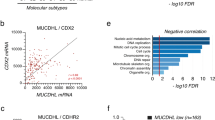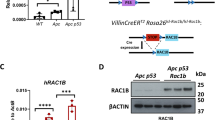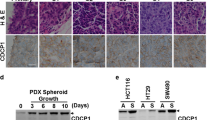Abstract
The development of colonic carcinoma is associated with the mutation of a specific set of genes1. One of these, DCC (deleted in colorectal cancer)2,3,4,5, is a candidate tumour-suppressor gene, and encodes a receptor for netrin-1, a molecule involved in axon guidance6,7,8. Loss of DCC expression in tumours is not restricted to colon carcinoma2, and, although there is no increase in the frequency of tumour formation in DCC hemizygous mice5, re-establishment of DCC expression suppresses tumorigenicity3,4. However, the mechanism of action of DCC is unknown. Here we show that DCC induces apoptosis in the absence of ligand binding, but blocks apoptosis when engaged by netrin-1. Furthermore, DCC is a caspase substrate, and mutation of the site at which caspase-3 cleaves DCC suppresses the pro-apoptotic effect of DCC completely. These results indicate that DCC may function as a tumour-suppressor protein by inducing apoptosis in settings in which ligand is unavailable (for example, during metastasis or tumour growth beyond local blood supply) through functional caspase cascades by a mechanism that requires cleavage of DCC at Asp 1,290.
This is a preview of subscription content, access via your institution
Access options
Subscribe to this journal
Receive 51 print issues and online access
$199.00 per year
only $3.90 per issue
Buy this article
- Purchase on Springer Link
- Instant access to full article PDF
Prices may be subject to local taxes which are calculated during checkout





Similar content being viewed by others
References
Fearon, E. R. et al. Identification of a chromosome 18q gene that is altered in colorectal cancers. Science 247, 49–56 (1990).
Fearon, E. R. DCC: is there a connection between tumorigenesis and cell guidance molecules? Biochim. Biophys. Acta 1288, M17–M23 (1996).
Tanaka, K. et al. Suppression of tumorigenicity in human colon carcinoma cells by introduction of normal chromosome 5 or 18. Nature 349, 340–342 (1991).
Klingelhutz, A. J., Hedrick, L., Cho, K. R. & McDougall, J. K. The DCC gene suppresses the malignant phenotype of transformed human epithelial cells. Oncogene 10, 1581–1586 (1995).
Fazeli, A. et al. Phenotype of mice lacking functional Deleted in colorectal cancer (Dcc) gene. Nature 386, 796–804 (1997).
Serafini, T. et al. Netrin-1 is required for commissural axon guidance in the developing vertebrate nervous system. Cell 87, 1001–1014 (1996).
Kennedy, T. E., Serafini, T., de la Torre, J. R. & Tessier-Lavigne, M. Netrins are diffusible chemotropic factors for commissural axons in the embryonic spinal cord. Cell 78, 425–435 (1994).
Keino-Masu, K. et al. Deleted in colorectal cancer (DCC) encodes a netrin receptor. Cell 87, 175–185 (1996).
Rabizaedh, S. et al. Induction of apoptosis by the low-affinity NGF receptor. Science 261, 345–348 (1993).
Rabizadeh, S. & Bredesen, D. E. Is p75NGFR involved in developmental neural cell death? Dev. Neurosci. 16, 207–211 (1994).
Bredesen, D. E. & Rabizadeh, S. p75NTR and apoptosis: Trk-dependent and Trk-independent effects. Trends Neurosci. 20, 287–290 (1997).
Bredesen, D. E. et al. p75NTR and the concept of cellular dependence: seeing how the other half die. Cell Death Differ. 5, 365–371 (1998).
Ellerby, L. M. et al. Kennedy's disease: caspase cleavage of the androgen receptor is a crucial event in cytotoxicity. J. Neurochem.(in the press).
Ellerby, H. M. et al. Establishment of a cell-free system for neuronal apoptosis: comparison of pre-mitochondrial, mitochondrial, and post-mitochondrial phases. J. Neurosci. 17, 6165–6178 (1997).
Thornberry, N. A. et al. Acombinatorial approach defines specificities of members of the caspase family and granzyme B. Functional relationships established for key mediators of apoptosis. J. Biol. Chem. 272, 17907–17911 (1997).
Yang, F. et al. Antibody to caspase-cleaved actin detects apoptosis in differentiated neuroblastoma and plaque-associated neurons and microglia in Alzheimer's disease. Am. J. Pathol. 152, 379–389 (1998).
Cho, K. R. & Fearon, E. R. DCC: linking tumor suppressor genes and altered cell surface interactions in cancer? Curr. Opin. Genet. Dev. 5, 72–78 (1995).
Kern, S. E.et al. Allelic loss in colorectal carcinomas. J. Am. Med. Assoc. 261, 3099–3103 (1989).
Bennett, K. L. et al. Deleted in colorectal carcinoma (DCC) binds heparin via its fifth fibronectin type III domain. J. Biol. Chem. 272, 26940–26946 (1997).
Pflug, B. R., Onoda, M., Lynch, J. H. & Djakiew, D. Reduced expression of the low affinity nerve growth factor receptor in benign and malignant human prostate tissue and loss of expression in four human metastic prostate tumor cell lines. Cancer Res. 52, 5403–5406 (1992).
Bredesen, D. E. in Apoptosis II: The Molecular Basis of Apoptosis in Diseas 397–421 (eds Tomei, L. D. & Cope, F. O.) (Cold Spring Harb. Lab. Press, Plainview, New York, (1994).
Mehlen, P., Kretz Remy, C., Preville, X. & Arrigo, A.-P. Human hsp27, Drosophila hsp27 and human αB-crystallin expression-mediated increase in glutathione is essential for the protective activity of these proteins against TNFα-induced cell death. EMBO J. 15, 2695–2706 (1996).
Ruan, Y., Camerini, D., Rabizadeh, S. & Bredesen, D. E. Expression of CD40 induces neural apoptosis. J. Neurosci. Res. 50, 383–390 (1997).
Mehlen, P. et al. Constitutive expression of either human hsp27, Drosophila hsp27 or human α-B crystallin confers resistance to tumor necrosis factor- and oxidative stress-induced cytotoxity in stably transfected murine L929 fibroblasts. J. Immunol. 154, 363–374 (1995).
Mehlen, P., Coronas, V., Ljubic, V., Jourdan, F. & Arrigo, A.-P. Small stress protein Hsp27 accumulation during dopamine-mediated differentiation of rat olfactory neurons counteracts apoptosis. Cell Death Differ.(in the press).
Reale, M. A. et al. Expression and alternative splicing of the deleted in colorectal cancer (DCC) gene in normal and malignant tissues. Cancer Res. 54, 4493–4501 (1994).
Rabizadeh, S. et al. Mechanism of neurotrophin dependence: requirement for a novel type of domain. Cell(submitted).
Jordan, M., Schallhorn, A. & Wurm, F. M. Transfecting mammalian cells: optimization of critical parameters affecting calcium-phosphate percipitate formation. Nucleic Acids Res. 24, 596–601 (1996).
Stennicke, H. R. & Salvesen, G. S. Biochemical characteristics of caspases-3, -6, -7, and -8. J. Biol. Chem. 272, 25719–25723 (1997).
Acknowledgements
We thank B. Vogelstein and E. Fearon for the DCC cDNA, M. Tessier-Lavigne for the netrin-1 cDNA, and F. Martin for the REGb cells. This work was supported in part by grants from the NIH and the VivoRx Corporation.
Author information
Authors and Affiliations
Corresponding author
Rights and permissions
About this article
Cite this article
Mehlen, P., Rabizadeh, S., Snipas, S. et al. The DCC gene product induces apoptosis by a mechanism requiring receptor proteolysis. Nature 395, 801–804 (1998). https://doi.org/10.1038/27441
Received:
Accepted:
Issue Date:
DOI: https://doi.org/10.1038/27441
This article is cited by
-
Coadaptation fostered by the SLIT2-ROBO1 axis facilitates liver metastasis of pancreatic ductal adenocarcinoma
Nature Communications (2023)
-
DCC/netrin-1 regulates cell death in oligodendrocytes after brain injury
Cell Death & Differentiation (2023)
-
Netrin-1 functions as a suppressor of bone morphogenetic protein (BMP) signaling
Scientific Reports (2021)
-
Cytogenetic characterization of the malignant primitive neuroectodermal SK-PN-DW tumor cell line
BMC Cancer (2019)
-
The Ectodysplasin receptor EDAR acts as a tumor suppressor in melanoma by conditionally inducing cell death
Cell Death & Differentiation (2019)
Comments
By submitting a comment you agree to abide by our Terms and Community Guidelines. If you find something abusive or that does not comply with our terms or guidelines please flag it as inappropriate.



